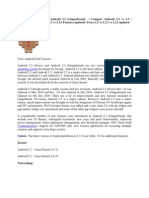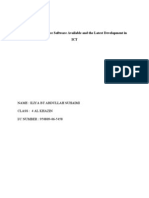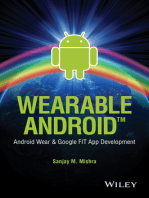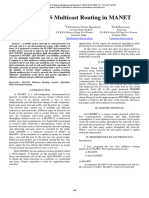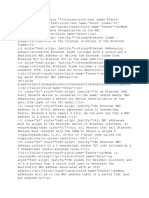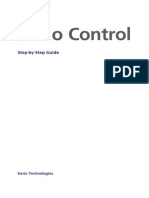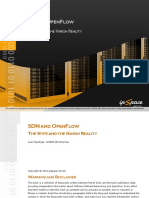Oftware Equirements Pecification: Ndroid Latform
Oftware Equirements Pecification: Ndroid Latform
Uploaded by
tanay9bhargavaOriginal Title
Copyright
Available Formats
Share this document
Did you find this document useful?
Is this content inappropriate?
Report this DocumentCopyright:
Available Formats
Oftware Equirements Pecification: Ndroid Latform
Oftware Equirements Pecification: Ndroid Latform
Uploaded by
tanay9bhargavaCopyright:
Available Formats
FOX Requirements Specifications Document
FOX
SOFTWARE REQUIREMENTS SPECIFICATION
DOCUMENT
ANDROID PLATFORM
VERSION: (1.0)
DATE: (12/10/2011)
1
12-10-2011
FOX Requirements Specifications Document
TABLE OF CONTENTS
1. Introduction ..............................................................................................................................................................3 1.1 Purpose ................................................................................................................................................................3 1.2 Scope....................................................................................................................................................................3 1.3 Definitions, Acronyms, and Abbreviations ..........................................................................................................3 1.4 References............................................................................................................................................................3 1.5 Overview .............................................................................................................................................................3 2. Overall Description ....................................................................................................................................................4 2.1 Product Perspective ............................................................................................................................................4 2.1.1 System Interface ..............................................................................................................................................4 2.1.2 Hardware Interfaces ........................................................................................................................................5 2.1.3 Software Interfaces ..........................................................................................................................................5 2.1.4 Communications Interfaces .............................................................................................................................6 2.2 Product Functions ...............................................................................................................................................6 2.3 User Characteristics ............................................................................................................................................7 2.4 Constraints ..........................................................................................................................................................8 2.5 Assumptions and Dependencies ..........................................................................................................................8 3. Specific Requirements ...............................................................................................................................................8 3.2 Performance Requirements .................................................................................................................................8 3.3 Logical Database Requirements ..........................................................................................................................9 Tables required :- .......................................................................................................................................................9 3.4 DesignConstraints ................................................................................................................................................9 4. Appendix ..................................................................................................................................................................10 4.1 Appendix a ..........................................................................................................................................................10
2 12-10-2011
FOX Requirements Specifications Document
1. INTRODUCTION
The purpose of this document is to present a detailed description of the system FOX. It will explain the purpose and features of the system, the interfaces of the system, what the system will do and the constraints under which it must operate. This document is intended for both the stakeholders and the developers of the system.
1.1 PURPOSE
The Purpose of FOX is to act as a voice based assistant informing the user about his/her schedule and daily activities through a voice based interface. The utility widgets like Calendar, Social Networking Sites and Weather etc. will be provided initially. More widgets can be added onto the framework later.
1.2 SCOPE
The system will consist of widgets. Widgets will interface the system to external applications like alarm, calendar, Weather etc. The system will speak out the data received by the widgets in a human voice. The user can interact with the system using commands. The system will process the voice input from user simultaneously as it speaks. The System starts up in two ways, one being Normal Start and second Alarm Start.
1.3 DEFINITIONS, ACRONYMS, AND ABBREVIATIONS
User : Client Android: OS on users device. Mobile Phone: Users handheld device.
1.4 REFERENCES
(1) http://developer.android.com (2) http://code.google.com (3) http://www.ispeech.org
1.5 OVERVIEW
In coming sections we have described the product FOX in varying levels of Detail. Section 2 deals with the Product Perspective which outlines all tangible requirements of the system, its interfaces and operational procedure. In
3 12-10-2011
FOX Requirements Specifications Document
section 3 we go in depth of Actual functional requirements, relations and databases, constraints and attributes of the system.
2. OVERALL DESCRIPTION
2.1 PRODUCT PERSPECTIVE
It is an application that will run on the users android based mobile phone. The user can perform the following operations: Set sequence of playback Play widgets. Set alarm. Example of some voice commands : a) Play b) Pause c) Next
d) Next Widget e) f) Remind Me Stop
2.1.1 SYSTEM INTERFACE
In order of appearance: Application Icon Splash screen Menu Screen a. b. c. d. e. f. Alarm Calendar Weather Facebook Birthdays Settings
Alarm Screen a. b. c. Set Time Set Tone Repeat On Days 4
12-10-2011
FOX Requirements Specifications Document
Calendar Widget Screen a. b. c. d. List of events Play button Delete Event Refresh
Settings Screen a. b. c. d. e. Voice Male/Female Sequence of events during playback Profile Facebook Connect About
Backgrounds
2.1.2 HARDWARE INTERFACES
Minimum Mobile Phone Requirements1) Touch Screen Display 2) 512MB RAM 3) 500 MB Flash Memory 4) 400MHz Processor
2.1.3 SOFTWARE INTERFACES
1) Android 2.2 OS 2) Text to speech engine 3) Speech to text engine 4) Example of Widgets Interface a. b. c. d. Calendar Weather Birthdays Facebook Etc.
5 12-10-2011
FOX Requirements Specifications Document
2.1.4 COMMUNICATIONS INTERFACES
GPRS General packet radio service (GPRS) is a packet oriented mobile data service on the 2G and 3G cellular communication system's global system for mobile communications (GSM). GPRS will be used to connect the users mobile device to the text to speech engine and speech to text.
Wi-Fi Wi-Fi is a mechanism for wirelessly connecting electronic devices. A device enabled with Wi-Fi, such as a personal computer, video game console, smartphone, or digital audio player, can connect to the Internet via a wireless network access point. An access point (or hotspot) has a range of about 20 meters (65 ft) indoors and a greater range outdoors 3G 3rd generation mobile telecommunications is a generation of standards for mobile phones and mobile telecommunication services fulfilling the International Mobile Telecommunications-2000 (IMT-2000) specifications by the International Telecommunication Union EDGE Enhanced Data rates for GSM Evolution (EDGE) (also known as Enhanced GPRS (EGPRS), or IMT Single Carrier (IMTSC), or Enhanced Data rates for Global Evolution) is a digital mobile phone technology that allows improved data transmission rates as a backward-compatible extension of GSM. EDGE is considered a pre-3G radio technology and is part of ITU's 3G definition 4G 4G is the fourth generation of cellular wireless standards. It is a successor to the 3G and 2G families of standards.A 4G system is expected to provide a comprehensive and secure all-IP based mobile broadband solution to laptop computer wireless modems, smartphones, and other mobile devices.It has data speed of 100 Mb/s 1 Gb/s.
2.2PRODUCT FUNCTIONS
Application Controller: get_voice_input():Accepts voice commands from user. speech_to_text(): Converts voice to text. analyze_text(): Analyzes text for commands. text_to_speech():Converts text to speech. 6 12-10-2011
FOX Requirements Specifications Document
scan_widgets():Checks if any new events have occurred on widgets. play_widgets():Plays widgets which have new events. set_alarm():User can set an alarm.
Widget: update_events():Updates the widget with the latest notifications. convert_events_data(): Converting notifications into a text format. delete_event(): Delete an event manually or after event expires.
2.3 USER CHARACTERISTICS
We have identified three potential classifications of users of our system: Software Designers: They will use the system as a means of laying out the design of an as yet unimplemented system. Software Developers: These are the people that take the model generated by the designers and implement it in code. The User: They will be the end-users who would interact with the system.
2.3.1 General Users All users can be assumed to have the following characteristics: Ability to read, speak, listen and understand English. Familiarity with the operation of the basic Graphical User Interface (GUI) components of the Android operating system. Beyond the above, no further facility with computer technology can be assumed.
2.3.2 The Software Designer The Software Designer users can be assumed to have the following characteristics: A thorough knowledge of object oriented design notation. Familiarity with common design environments.
2.3.3 The Software Developer The Software developer users can be assumed to have the following characteristics: A thorough knowledge of object oriented programming. 7 12-10-2011
FOX Requirements Specifications Document
An understanding of development in Android operating system.
2.4 CONSTRAINTS
Users mobile phone must be connected to the internet for data processing. The events will be updated in real time. Incase there is no connectivity the application will not be able update the widgets dependant on internet. In absence of internet access, the application will not be able to speak out the widget data in customized human voice. Notifications will be delivered to user in default robotic voice.
2.5 ASSUMPTIONS AND DEPENDENCIES
The user cannot control the external applications through the system. The system will not guarantee the information provided by external applications. The user will have to set the alarm on the system. The external alarm application will not be interfaced with the system. External application Authorization Widgets such as facebook will require authorization.
3. SPECIFIC REQUIREMENTS
3.1 EXTERNAL INTERFACES
The System shall primarily have two external interfaces: Text-to-Speech engine: Facebook Connect: ispeech text-to-speech SDK shall be used. For Facebook Alerts Facebook Mobile SDK shall be used.
3.2 PERFORMANCE REQUIREMENTS
The performance of this product is dependent on the underlying hardware. To ensure the specified performance can be achieved, the following hardware is required. 1) 400MHz Processor 2) 512MB RAM 3) 30 MB Flash Memory
8 12-10-2011
FOX Requirements Specifications Document
4) GPRS/EDGE/Wi-Fi/3G/4G internet connectivity with minimum bandwidth of 56 Kb/s 3.2.1 System Response Time The System shall be a real-time system with 99% of interactions being less than 10 micro seconds duration. Other 1% is accounted for hardware failure and unresponsive internet connection wherein duration of Time-out would range from 50 micro seconds to 1 second. 3.2.2 System Throughput The Throughput of the System is dependent on internet connectivity. The throughput of the system is dependent on the amount of requests ispeech servers can handle, which is beyond the systems control. 3.2.3 System Concurrency The system is concurrently producing output and accepting input. The system concurrency is dependent on user input.
3.3 LOGICAL DATABASE REQUIREMENTS
Database Management System 1) Sqlite (Mobile Phone) Tables required :1. Widgets Database --WID, Name, Version, Ispurchased, Visible, Position, Priority, last_update
2.
Events Database (Internal) -- EID,Created_time,notification_text, notification_time.
3.4 DESIGNCONSTRAINTS
The system is designed for the Android operating system. The human voice produced as output is dependent on the sound quality of the device.
9 12-10-2011
FOX Requirements Specifications Document
4. APPENDIX 4.1 APPENDIX A
TABLES
Database Tables :
1) Widgets Database
Attribute Name WID Name Version Ispurchased Visible Position Priority Last_Update
Attribute Type NUM VARCHAR NUM BOOL BOOL NUM NUM DATE
Primary Key YES NO NO NO NO NO NO NO
2) Events Database Attribute Name EID Created_time Notification_text Notification_time Attribute Type NUM DATE VARCHAR DATE Primary Key YES NO NO NO
10 12-10-2011
You might also like
- 5G KPI 5G Optimization and TroubleshootingDocument3 pages5G KPI 5G Optimization and TroubleshootingAlexandre Ayeh67% (3)
- 800 16038 Galaxy Remote Connect AppUser Manual PDFDocument18 pages800 16038 Galaxy Remote Connect AppUser Manual PDFMarian PNo ratings yet
- Digital TransmissionDocument59 pagesDigital TransmissionNeslynNo ratings yet
- Huawei Smart City Overview PresentationDocument41 pagesHuawei Smart City Overview PresentationĐộ Ngô QuýNo ratings yet
- Graduation Project: Roverbot - ThesisDocument122 pagesGraduation Project: Roverbot - ThesisAhmed Mahdy100% (2)
- Design Document Android Based PC Controller: Project Code: BSEF13E024Document17 pagesDesign Document Android Based PC Controller: Project Code: BSEF13E024usmanNo ratings yet
- Bluetooth TPPDocument4 pagesBluetooth TPPMangesh MahadikNo ratings yet
- A Comparative Study of Mobile Operating Systems With Special Emphasis On Android OSDocument55 pagesA Comparative Study of Mobile Operating Systems With Special Emphasis On Android OSDVDNo ratings yet
- Obile Luetooth Ervices: (Final Year B.Tech Project Presentation)Document21 pagesObile Luetooth Ervices: (Final Year B.Tech Project Presentation)Prasanth_Param_5978No ratings yet
- Cse 2200-Software Development Project: Name of The Project: Wireless Controlling PCDocument19 pagesCse 2200-Software Development Project: Name of The Project: Wireless Controlling PCrameshscribdNo ratings yet
- Name: I.C Number: Form: Subject: Subject'S TeacherDocument6 pagesName: I.C Number: Form: Subject: Subject'S TeacherEjad AdhaNo ratings yet
- Software Requirements SpecificationDocument33 pagesSoftware Requirements SpecificationHarish Chadalawada38% (8)
- AndroidDocument10 pagesAndroidsudiptakumarjena20No ratings yet
- Identifying of Objects Using RF Transmitter and Receiver and Data Retrieving Using GSMDocument111 pagesIdentifying of Objects Using RF Transmitter and Receiver and Data Retrieving Using GSMaymangafferNo ratings yet
- Ict Assignment 1Document11 pagesIct Assignment 1Iliya SuhaimiNo ratings yet
- Odoo MobileDocument83 pagesOdoo MobileAnonymous Fs0xC9100% (1)
- One Firmware To Monitor 'Em All.: Andr Es Blanco Matias Eissler Core Security Technologies August 23, 2012Document12 pagesOne Firmware To Monitor 'Em All.: Andr Es Blanco Matias Eissler Core Security Technologies August 23, 2012Emilio ArenasNo ratings yet
- The Latest Development in Networks and Communications: TitleDocument8 pagesThe Latest Development in Networks and Communications: Titlejjs144No ratings yet
- Speech Operated Home Appliances Control System by Using An Android ApplicationDocument58 pagesSpeech Operated Home Appliances Control System by Using An Android ApplicationsaiNo ratings yet
- Seminar On Android: Sanjay Kr. Gupta 7 Sem., E.CDocument17 pagesSeminar On Android: Sanjay Kr. Gupta 7 Sem., E.CRahul AgarwalNo ratings yet
- Panchwati Institute of Engg. & Technology: Submitted byDocument17 pagesPanchwati Institute of Engg. & Technology: Submitted byzianchNo ratings yet
- Information Communication Technology: The Latest Open Source Software Available and The Latest Development in IctDocument10 pagesInformation Communication Technology: The Latest Open Source Software Available and The Latest Development in IctLim SuyingNo ratings yet
- Security in Android Based SmartphoneDocument6 pagesSecurity in Android Based SmartphoneInternational Journal of Application or Innovation in Engineering & ManagementNo ratings yet
- JunyaoZhang ProjectDocument20 pagesJunyaoZhang ProjectAmine HedhiriNo ratings yet
- What Does Consumer Satisfaction Towards Operating System (Ios and Android) of Phones Mean?Document15 pagesWhat Does Consumer Satisfaction Towards Operating System (Ios and Android) of Phones Mean?Cherin SamNo ratings yet
- User Manual For G2EP G4EP FI9912EP QJ2 QJ4 V1.1 - EnglishDocument70 pagesUser Manual For G2EP G4EP FI9912EP QJ2 QJ4 V1.1 - EnglishbjorncotteleerNo ratings yet
- Ict ProjectDocument11 pagesIct ProjectZharfan SufianNo ratings yet
- CHAPTER 1: Improvisation in Analysis, Design and ModellingDocument33 pagesCHAPTER 1: Improvisation in Analysis, Design and ModellingAbhi MedirattaNo ratings yet
- Epplus Web v3.0Document21 pagesEpplus Web v3.0Thong Dang SyNo ratings yet
- Android Material DocumentDocument203 pagesAndroid Material DocumentParitala RamcNo ratings yet
- Android OS: Name: Ganesh Waghmare University Exam No.: T3384333Document28 pagesAndroid OS: Name: Ganesh Waghmare University Exam No.: T3384333Hitesh PatelNo ratings yet
- Sekolah Menengah Kebangsaan Tanjung Gemok Information and Communication Technology 3 7 6 5 / 2 Sijil Pelajaran Malaysia (2 0 1 2 / 2 0 1 3)Document10 pagesSekolah Menengah Kebangsaan Tanjung Gemok Information and Communication Technology 3 7 6 5 / 2 Sijil Pelajaran Malaysia (2 0 1 2 / 2 0 1 3)Suriaraj KrishnanNo ratings yet
- Bluetooth Application 1Document8 pagesBluetooth Application 1somendumaitiNo ratings yet
- Java Application Descriptor (Jad) Files Describe The: Midlets Java Me Jar Files Java Web Services Sms GSMDocument8 pagesJava Application Descriptor (Jad) Files Describe The: Midlets Java Me Jar Files Java Web Services Sms GSManooppaulNo ratings yet
- Desktop Assistant: Year 2020-2021Document19 pagesDesktop Assistant: Year 2020-2021spectorNo ratings yet
- Android OSDocument19 pagesAndroid OSUjjaval VadviNo ratings yet
- Project Synopsis LatestDocument9 pagesProject Synopsis LatestekagraNo ratings yet
- Remote Control PC: Minor Project (IT-413) Report OnDocument25 pagesRemote Control PC: Minor Project (IT-413) Report OnMike PrinceNo ratings yet
- Bt3420 SRK Project Report (Ete) - Ms Garima RathiDocument25 pagesBt3420 SRK Project Report (Ete) - Ms Garima RathiAlok Kumar YadavNo ratings yet
- The Latest Open Source SoftwareDocument9 pagesThe Latest Open Source SoftwareIzwan Ewan0% (1)
- Smart CircularDocument54 pagesSmart CircularAnil ReddyNo ratings yet
- Imp Question McadDocument19 pagesImp Question McadBurhanuddin UdaipurwalaNo ratings yet
- Bluetoothchat Mobile App: Software Requirements SpecificationDocument18 pagesBluetoothchat Mobile App: Software Requirements SpecificationMuhamamd naveed shahzadNo ratings yet
- Introduction of AndroidDocument9 pagesIntroduction of AndroidVaibhav HatodeNo ratings yet
- Remote Monitoring SystemDocument34 pagesRemote Monitoring SystemAnjai JacobNo ratings yet
- NarawieDocument4 pagesNarawieNabilla JustinNo ratings yet
- Power Point Presentation Android TechnologyDocument21 pagesPower Point Presentation Android Technologynitish_singh_1No ratings yet
- Spar Key Technical RequirementsDocument4 pagesSpar Key Technical RequirementsanlemacoNo ratings yet
- Sekolah Menengah Kebangsaan Serdang, 09800, Serdang Kedah, Darul AmanDocument11 pagesSekolah Menengah Kebangsaan Serdang, 09800, Serdang Kedah, Darul Amanchinglove1314No ratings yet
- Android OS: Name: Ganesh Waghmare University Exam No.: T3384333Document28 pagesAndroid OS: Name: Ganesh Waghmare University Exam No.: T3384333ganeshwaghmare71100% (1)
- Hytera SmartDispatch-Net Feature Book V4.0Document20 pagesHytera SmartDispatch-Net Feature Book V4.0tanajm60No ratings yet
- Hydroponic System: (STM32 Microcontroller Project)Document22 pagesHydroponic System: (STM32 Microcontroller Project)Anonymous At7Esm9xGHNo ratings yet
- S05 Loh Ka YangDocument10 pagesS05 Loh Ka YangRidzuan WrNo ratings yet
- Exploitation of A Modern Smartphone BasebandDocument17 pagesExploitation of A Modern Smartphone Basebandhanguelk internship100% (1)
- Unit - I Android and Development Environments: Various Mobile TechnologiesDocument23 pagesUnit - I Android and Development Environments: Various Mobile Technologiestest mailNo ratings yet
- 10 IntroductionDocument7 pages10 IntroductionMohd Syafiq ZhafriNo ratings yet
- Research On Application System of Remote-Control CDocument7 pagesResearch On Application System of Remote-Control CNishika PalNo ratings yet
- Reviewer 3 ICTDocument9 pagesReviewer 3 ICTnempharelay02No ratings yet
- IJRET20120103031 Head Line MismatchDocument5 pagesIJRET20120103031 Head Line MismatchesatjournalsNo ratings yet
- Wearable Android: Android Wear and Google FIT App DevelopmentFrom EverandWearable Android: Android Wear and Google FIT App DevelopmentNo ratings yet
- Electronics Projects with the ESP8266 and ESP32: Building Web Pages, Applications, and WiFi Enabled DevicesFrom EverandElectronics Projects with the ESP8266 and ESP32: Building Web Pages, Applications, and WiFi Enabled DevicesRating: 1 out of 5 stars1/5 (1)
- Cybersecurity Lab MaualDocument66 pagesCybersecurity Lab MaualJatin PrajapatNo ratings yet
- Neeraj Kumar: Nokia Siemens Networks (Global SDC Chennai)Document4 pagesNeeraj Kumar: Nokia Siemens Networks (Global SDC Chennai)Kuldeep SharmaNo ratings yet
- JEBA & SAVISOORIYAJA Journal 5Document6 pagesJEBA & SAVISOORIYAJA Journal 5Jebakumar Gomer RajaduraiNo ratings yet
- List of Goods - Belden Cables and Wires and ComponentsDocument4 pagesList of Goods - Belden Cables and Wires and Componentsprince olanNo ratings yet
- Designing Open RAN PlatformsDocument27 pagesDesigning Open RAN PlatformsSourub KushwahNo ratings yet
- Itn Module 7Document5 pagesItn Module 7catiafantunesNo ratings yet
- Kerio Control - Step-By-Step GuideDocument26 pagesKerio Control - Step-By-Step GuideJose PerezNo ratings yet
- ZTE Swap LinksDocument4 pagesZTE Swap LinksMichalMichalNo ratings yet
- XDM 1000Document2 pagesXDM 1000shraddha_karelia5456No ratings yet
- PCIeDocument93 pagesPCIeKonica Sarker100% (3)
- NEC PASOLINK TrainingDocument108 pagesNEC PASOLINK Trainingpurgedsoul100% (13)
- Internet Cafe ManualDocument141 pagesInternet Cafe ManualErlanNo ratings yet
- Ece Free Space OpticsDocument14 pagesEce Free Space OpticsSafalsha BabuNo ratings yet
- Hioso EPON SystemDocument120 pagesHioso EPON SystemMuh Khaidir Sakti JenarNo ratings yet
- 2 - Access Layer (Phase 1)Document32 pages2 - Access Layer (Phase 1)MostafaEl-sayedNo ratings yet
- Capstone:4001: Erification of The U.S.BDocument14 pagesCapstone:4001: Erification of The U.S.BSankeerth MamidalaNo ratings yet
- Assignment 12: 1. Find, and Comment Upon, ITU-R Recommendation P.528Document4 pagesAssignment 12: 1. Find, and Comment Upon, ITU-R Recommendation P.528LuisaF.ValderramaNo ratings yet
- Nokia Dynamic Spectrum Sharing For Rapid 5G White Paper enDocument12 pagesNokia Dynamic Spectrum Sharing For Rapid 5G White Paper enghf hg100% (2)
- Data Bridge 2Document19 pagesData Bridge 2Ale NqnNo ratings yet
- Sendquick Installation Guide PDFDocument2 pagesSendquick Installation Guide PDFpeterlimttkNo ratings yet
- AZ-104 Exam - 05Document182 pagesAZ-104 Exam - 05César Enrique GarcíaNo ratings yet
- DarkAudax - Aircrack-Manual (2010)Document27 pagesDarkAudax - Aircrack-Manual (2010)Asta1986No ratings yet
- Videocon D2H PUNE SaurabhDocument49 pagesVideocon D2H PUNE SaurabhSaurabh Singh SachanNo ratings yet
- K 78210250Document2 pagesK 78210250Nuno MonteiroNo ratings yet
- Smart Xhaul Hybrid Active Passive Solution For Small Cell TransportDocument3 pagesSmart Xhaul Hybrid Active Passive Solution For Small Cell TransportJose ValenzuelaNo ratings yet
- B0 - SDN and OpenFlow - The Harsh RealityDocument271 pagesB0 - SDN and OpenFlow - The Harsh RealityDimitarNo ratings yet












